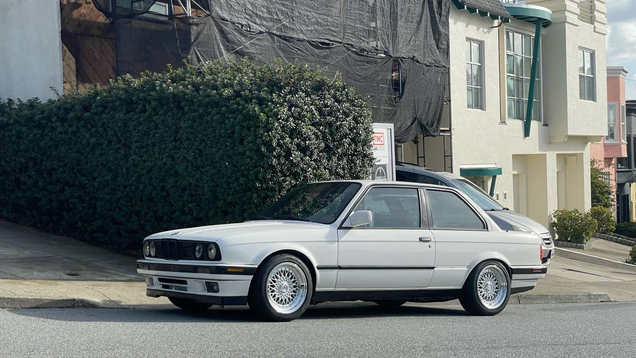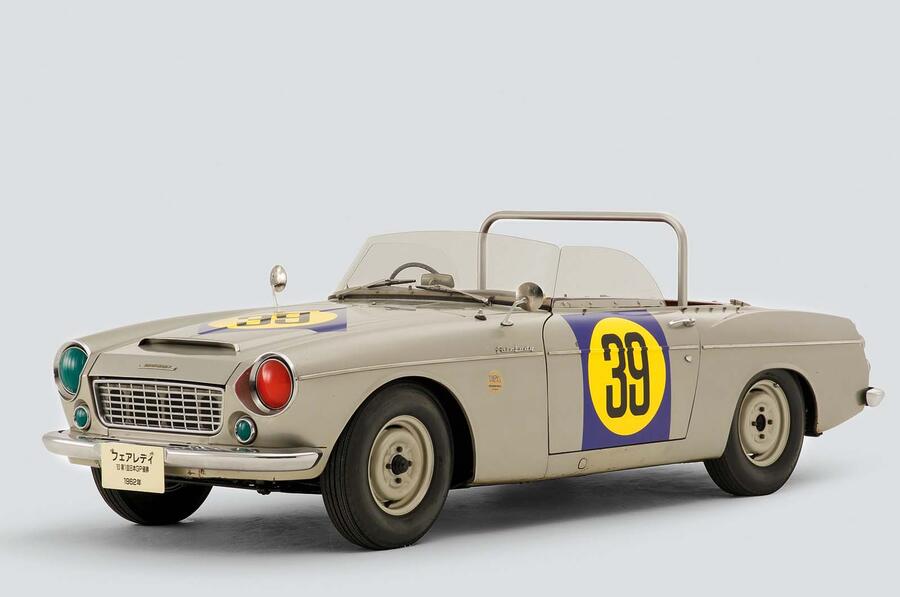Featured
“Mind-Blowing $27K S52-Swapped 1991 BMW 318i | Giga Gears”

BMW fans hold the ’80s E30 in extremely high regard. Today’s Nice Price or No Dice 318i has been upgraded with a supercharged S52 straight six, replacing its puny four. Let’s see if that warrants a supercharged price tag.

“Comic Opera Scenes at Japan’s First GP | Giga Gears”
 We reveal the chaos from the debut race at the storied Suzuka race track
We reveal the chaos from the debut race at the storied Suzuka race track
Doing something for the first time is rarely easy, and especially not when those around you are experienced at it. Have a little sympathy, then, for the plight of the Japan Automobile Sports Association (Jasa) in May 1963, as it hosted the burgeoning nation’s first international grand prix meeting.
The stage was splendid Suzuka, opened just eight months prior. No expense had been spared by Honda in the venue’s construction, it being primarily intended as a proving ground for the manufacturer’s motorcycles.
However, as Autocar put it: “Despite excellent amenities, an interesting field of international drivers and cars and efficient pre-race planning, there was little to attract a spectator back.”
You see, while each day’s top-billing sports car race ran flawlessly (in fact, they were “near carbon copies” that offered “little excitement”, with Lotus 23 drivers filling both podiums), the support races were absolutely chaotic.
Enjoy full access to the complete Autocar archive at themagazineshop.com
We explained: “There were no efforts during scrutineering to see that the cars complied with [the FIA’s] regulations. No notice was taken of cars normally fitted with three-speed gearboxes which resplendently boasted four speeds.
Other cars had dual electric petrol pumps supplementing their mechanical ones. Several cars shed bumpers and grilles or changed windscreens after scrutineering.”
Team representatives’ loud protests won them reinspections, but Jasa still wasn’t thorough. And then when it became apparent that some Japanese manufacturers had homologated “all sorts of optional gear and axle ratios”, precluding fair comparisons, it announced that no protests would be accepted except in respect of weight and capacity – despite Hillman having previously been told that it couldn’t enter the commercially available twin-carb version of its Minx.
Further still, one of the British drivers mentioned that nobody had asked to see a medical certificate or international competition licence. In fact, we heard that at least two drivers lacked the latter and one had never even raced on a track!
This may explain the “appalling carnage rate” in the touring car field: 23 of the 100 were written off in practice and a similar number in the races, and many drivers complained of being forced off.
The sub-1300cc GT race was hotly contested between five cars but rather spoiled, first on lap 10 by one taking the hairpin on its roof (“did she fall or was she pushed?”), then the winning Austin-Healey being disqualified for an undersized screen, suspiciously to the benefit of a well-known local motorbike racer.

Less contentious, if not entirely so, after “all sorts of remarkable goodies had been added to the homologation certificate just weeks before”, was a Datsun Fairlady’s win over Triumphs and MGs in the 1300-2500cc GT contest.
The day ended “shambolically” with the 1300-1600cc touring car race. Vauxhall Victor driver Soichi Sakai started swerving down the main straight, more severely lap after lap, to the point that the Toyota Corona driver behind, “leaning on his horn in desperation”, “came very close to collecting a pit signalling man”.
The crowd howled in protest and at the finish “nearly lynched” the “rather crestfallen” Sakai, while his fellow podium finishers walked off in disgust. The stewards then disqualified him, but why hadn’t they done so during the race? It turned out they had been “otherwise engaged” – not that they had a black flag to wave anyway.
Amazingly, even stranger things happened on the second day. Jaguar E-Type driver Arthur Owen was so fast in the over-2500cc GT race that rivals requested his disqualification or retirement, as he’d been “invited only to race, not to win”! He refused, but Jasa gave the trophy to second-placed Tatsu Yokoyama anyway.
“It is doubtful if [the Brit’s] feelings were made any less bitter on being handed a trophy inscribed in Japanese ‘Best Performance by Guest’,” we quipped.
All’s well that ends well, though, and returning to Suzuka in 1964, we were delighted by “a tremendous improvement in the standard of driving and sportsmanship”.
“Where Are All the Good Vans? | Giga Gears”

Minivans used to be all the rage. Every suburban household with two and a half children had to have the newest and most tech-filled people hauler. The auto industry pumped these out by the millions for decades. Every automaker worth their salt had to have a minivan in their lineup, and each one had its own cool…

Leapmotor T03: Giga Gears Overview
 Nascent Chinese electric car brand arrives in Europe with tiny electric city car
We’ve lost count of the number of Chinese brands that are coming to the UK, invariably planning to offer us the novelty of electric cars that look like they were styled by AI and named as imaginatively as your average photocopier.The Leapmotor T03 appears to perfectly fit the stereotype – except, it has one very important difference to its compatriots.You see, Leapmotors sold outside of China – starting with the T03 baby hatchback tested here and the big C10 family SUV – are actually sold by Leapmotor International, a joint venture owned 49:51 by the nascent Chinese company and Stellantis, the multinational giant that runs 14 brands from France, Italy, Germany, Britain and the US.The benefit of this, Leapmotor International CEO Tianshu Xin told us, is twofold: the brand can bypass the expensive set-up phase by simply adding its range to existing Stellantis showrooms across the nation; and potential customers will be reassured by familiarity and “360deg of support during the entire experience, from the selection of the vehicle to financing solutions and post-sales assistance services”. To say that Leapmotor – which began in Hangzhou a mere eight years ago by Zhu Jiangming, an electrical engineer with no prior automotive experience – is being ambitious about its growth abroad would be an understatement.It’s launching in Europe (including the UK), India, South-East Asia, Oceania and South America within the space of a year and expects to sell 250,000 cars this year – almost double its 2023 total – and 500,000 in 2030.It has defined its key brand values as affordability (it claims the T03 is the car that finally gives A- and B-segment buyers access to electric power, although the Dacia Spring will have something to say about that) and cutting-edge technology that takes the hassle out of your daily life.It certainly is one of the cheapest electric cars on sale at a mere £16k: that Leapmotor makes the majority of its parts in-house, hasn’t designed in superfluities and is harnessing Stellantis economies of scale apparently help the price, as does it being made on the old Fiat 500 line in Poland, not in China, and therefore avoiding both shipping costs and a 20% EU import tariff. View this post on Instagram A post shared by Autocar (@autocar_official)
Nascent Chinese electric car brand arrives in Europe with tiny electric city car
We’ve lost count of the number of Chinese brands that are coming to the UK, invariably planning to offer us the novelty of electric cars that look like they were styled by AI and named as imaginatively as your average photocopier.The Leapmotor T03 appears to perfectly fit the stereotype – except, it has one very important difference to its compatriots.You see, Leapmotors sold outside of China – starting with the T03 baby hatchback tested here and the big C10 family SUV – are actually sold by Leapmotor International, a joint venture owned 49:51 by the nascent Chinese company and Stellantis, the multinational giant that runs 14 brands from France, Italy, Germany, Britain and the US.The benefit of this, Leapmotor International CEO Tianshu Xin told us, is twofold: the brand can bypass the expensive set-up phase by simply adding its range to existing Stellantis showrooms across the nation; and potential customers will be reassured by familiarity and “360deg of support during the entire experience, from the selection of the vehicle to financing solutions and post-sales assistance services”. To say that Leapmotor – which began in Hangzhou a mere eight years ago by Zhu Jiangming, an electrical engineer with no prior automotive experience – is being ambitious about its growth abroad would be an understatement.It’s launching in Europe (including the UK), India, South-East Asia, Oceania and South America within the space of a year and expects to sell 250,000 cars this year – almost double its 2023 total – and 500,000 in 2030.It has defined its key brand values as affordability (it claims the T03 is the car that finally gives A- and B-segment buyers access to electric power, although the Dacia Spring will have something to say about that) and cutting-edge technology that takes the hassle out of your daily life.It certainly is one of the cheapest electric cars on sale at a mere £16k: that Leapmotor makes the majority of its parts in-house, hasn’t designed in superfluities and is harnessing Stellantis economies of scale apparently help the price, as does it being made on the old Fiat 500 line in Poland, not in China, and therefore avoiding both shipping costs and a 20% EU import tariff. View this post on Instagram A post shared by Autocar (@autocar_official) 
